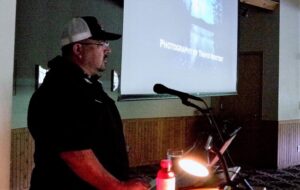Grand Portage Anishinaabe Nation photographer brings life to history through night sky photography

By Rick Garrick
THUNDER BAY — Grand Portage Anishinaabe Nation photographer Travis Novitsky recently shared his night sky photography featuring the Milky Way and Aurora Borealis on July 10 at Fort William Historical Park. Novitsky’s presentation was part of Fort William Historical Park’s The Great Rendezvous celebration of 50 years of bringing life to history, held July 8-16.
“I’ve loved the night sky pretty much for as long as my memory goes, which is getting close to 50 years now, from nights spent with my dad while he was capturing images of the sky on film to after dark walks with my mom to moonlight nights and bike rides,” Novitsky says. “The night sky has always been there and I’ve always loved it. It’s a different world from that of the daylight hours, as I often like to say, nighttime is a magic time, the world looks different at night, more mysterious, sound travels differently, the quality of light on the landscape defies description. A night spent under the glow of the sky filled with stars and/or the dancing lights of the Aurora Borealis, those are some of the best memories I have.”
Novitsky, a proud citizen and lifelong resident of the Grand Portage Anishinaabe Nation at the northeastern tip of Minnesota, says he usually uses a full-frame digital camera and a 14 mm lens for his night sky photography.
“My approach to photography is very much a mindful process that I put a lot of thought and planning into,” he says. “I like to think of that method not as taking pictures but rather making photographs, and much like other people make their art, I make my art as well.”
Novitsky says he spends a lot of time during the daylight hours scouting for possible locations to photograph the night sky, keeping an eye on where the Milky Way might line up.
“So, when I find a lake, for example, that has an intriguing curve to the shoreline and some nice pine trees or some other foreground element, I’m always looking at the direction and I’m thinking ahead, in my mind I’m trying to visualize what that area will look like at night, whether the Milky Way will line up or whether it will be a good spot for some Northern Lights,” Novitsky says. “Then I will start to plan for when I might want to go back there at night and photograph this place. In some cases, there are many hours if not days invested in scouting a location, sometimes years pass before I make it back there to photograph at night.”
Novitsky says he usually arrives on location for his night sky photography about an hour or two before the sun goes down.
“Once my tripod and camera are set up or sometimes I’ll do that later, I’ll just sit there or I’ll lay on the ground for several minutes and just listen to what’s going on around me,” Novitsky says.
Novitsky’s says the PBS documentary, Northern Nights, Starry Skies, which he co-produced and features his night sky photography, celebrates star bright skies, dark sky places and Indigenous star knowledge and stewardship of the night sky.
“Even though I grew up on tribal land, Indigenous star knowledge has been kind of hard to come by,” Novitsky says, noting that he has been learning more about Indigenous star knowledge from Carl Gawboy, an artist and retired professor from the Bois Forte Band of Chippewa in Minnesota. “Carl worked with us pretty closely on the documentary and has graciously given me the permission to share in my presentation some of the stories that I’ve learned from him and from his book, which is called Talking Sky.”


